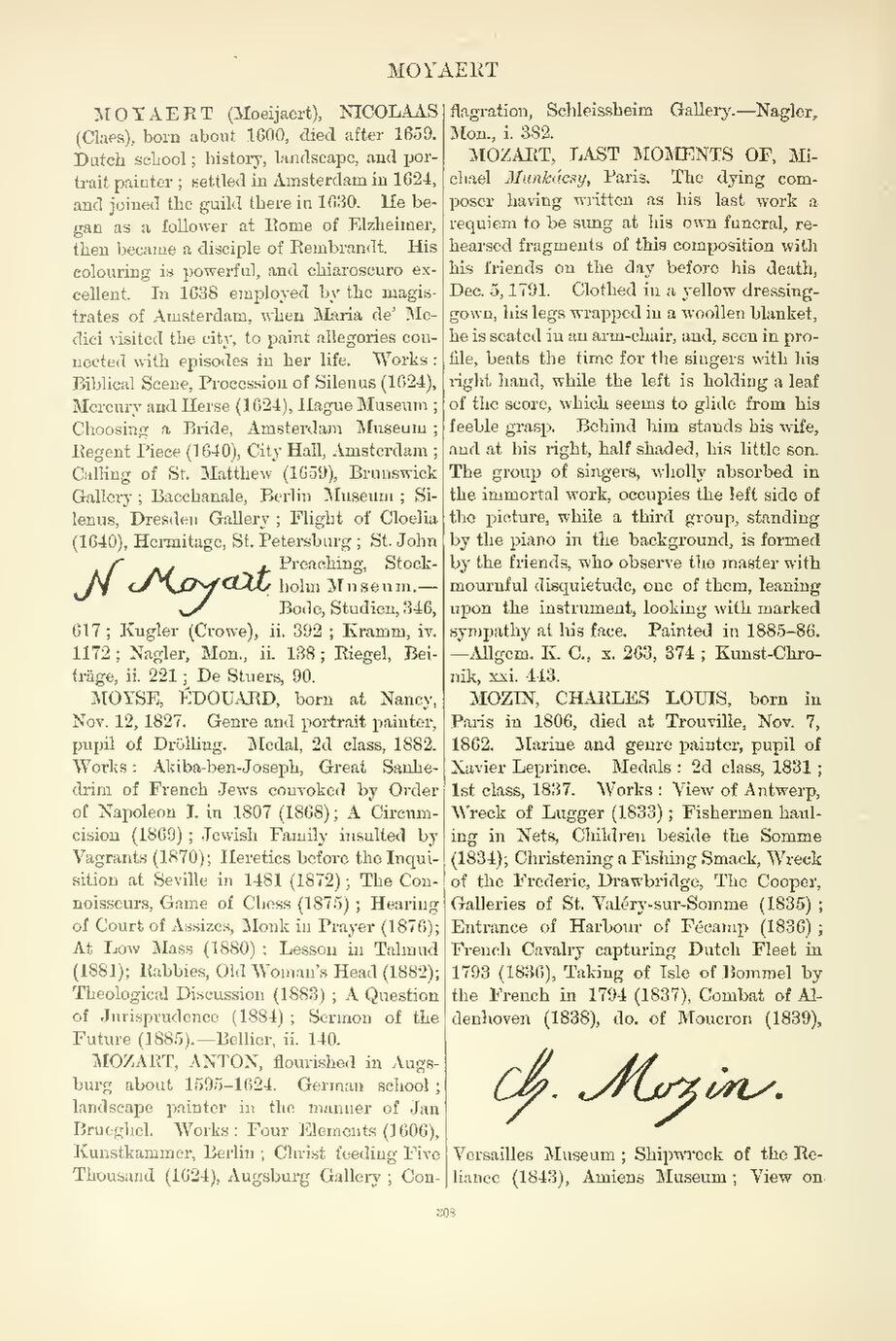An image should appear at this position in the text. To use the entire page scan as a placeholder, edit this page and replace "{{missing image}}" with "{{raw image|Cyclopedia of painters and paintings (IA cyclopediaofpain03cham).pdf/330}}". Otherwise, if you are able to provide the image then please do so. For guidance, see Wikisource:Image guidelines and Help:Adding images. |
MOYAERT (Moeijaert), NICOLAAS
(Claes), born about 1600, died after 1659.
Dutch school; history, landscape, and portrait
painter; settled in Amsterdam in 1624,
and joined the guild there in 1630. He began
as a follower at Rome of Elzheimer,
then became a disciple of Rembrandt. His
colouring is powerful, and chiaroscuro excellent.
In 1638 employed by the magistrates
of Amsterdam, when Maria de' Medici
visited the city, to paint allegories connected
with episodes in her life. Works:
Biblical Scene, Procession of Silenus (1624),
Mercury and Herse (1624), Hague Museum;
Choosing a Bride, Amsterdam Museum;
Regent Piece (1640), City Hall, Amsterdam;
Calling of St. Matthew (1659), Brunswick
Gallery; Bacchanale, Berlin Museum; Silenus,
Dresden Gallery; Flight of Cloelia
(1640), Hermitage, St. Petersburg; St. John
Preaching, Stockholm
Museum.—Bode,
Studien, 346,
617; Kugler (Crowe), ii. 392; Kramm, iv.
1172; Nagler, Mon., ii. 138; Riegel, Beiträge,
ii. 221; De Stuers, 90.
MOYSE, ÉDOUARD, born at Nancy,
Nov. 12, 1827. Genre and portrait painter,
pupil of Drölling. Medal, 2d class, 1882.
Works: Akiba-ben-Joseph, Great Sanhedrim
of French Jews convoked by Order
of Napoleon I. in 1807 (1868); A Circumcision
(1869); Jewish Family insulted by
Vagrants (1870); Heretics before the Inquisition
at Seville in 1481 (1872); The Connoisseurs,
Game of Chess (1875); Hearing
of Court of Assizes, Monk in Prayer (1876);
At Low Mass (1880); Lesson in Talmud
(1881); Rabbies, Old Woman's Head (1882);
Theological Discussion (1883); A Question
of Jurisprudence (1884); Sermon of the
Future (1885).—Bellier, ii. 140.
MOZART, ANTON, flourished in Augsburg
about 1595-1624. German school;
landscape painter in the manner of Jan
Brueghel. Works: Four Elements (1606),
Kunstkammer, Berlin; Christ feeding Five
Thousand (1624), Augsburg Gallery; Conflagration,
Schleissheim Gallery.—Nagler,
Mon., i. 382.
MOZART, LAST MOMENTS OF, Michael
Munkácsy, Paris. The dying composer
having written as his last work a
requiem to be sung at his own funeral, rehearsed
fragments of this composition with
his friends on the day before his death,
Dec. 5, 1791. Clothed in a yellow dressing-gown,
his legs wrapped in a woollen blanket,
he is seated in an arm-chair, and, seen in profile,
beats the time for the singers with his
right hand, while the left is holding a leaf
of the score, which seems to glide from his
feeble grasp. Behind him stands his wife,
and at his right, half shaded, his little son.
The group of singers, wholly absorbed in
the immortal work, occupies the left side of
the picture, while a third group, standing
by the piano in the background, is formed
by the friends, who observe the master with
mournful disquietude, one of them, leaning
upon the instrument, looking with marked
sympathy at his face. Painted in 1885-86.—Allgem.
K. C., x. 263, 374; Kunst-Chronik,
xxi. 443.
An image should appear at this position in the text. To use the entire page scan as a placeholder, edit this page and replace "{{missing image}}" with "{{raw image|Cyclopedia of painters and paintings (IA cyclopediaofpain03cham).pdf/330}}". Otherwise, if you are able to provide the image then please do so. For guidance, see Wikisource:Image guidelines and Help:Adding images. |
MOZIN, CHARLES LOUIS, born in
Paris in 1806, died at Trouville, Nov. 7,
1862. Marine and genre painter, pupil of
Xavier Leprince. Medals: 2d class, 1831;
1st class, 1837. Works: View of Antwerp,
Wreck of Lugger (1833); Fishermen hauling
in Nets, Children beside the Somme
(1834); Christening a Fishing Smack, Wreck
of the Frederic, Drawbridge, The Cooper,
Galleries of St. Valéry-sur-Somme (1835);
Entrance of Harbour of Fécamp (1836);
French Cavalry capturing Dutch Fleet in
1793 (1836), Taking of Isle of Bommel by
the French in 1794 (1837), Combat of Aldenhoven
(1838), do. of Moucron (1839),
Versailles Museum; Shipwreck of the Reliance
(1843), Amiens Museum; View on
